Michelangelo’s Tarpon
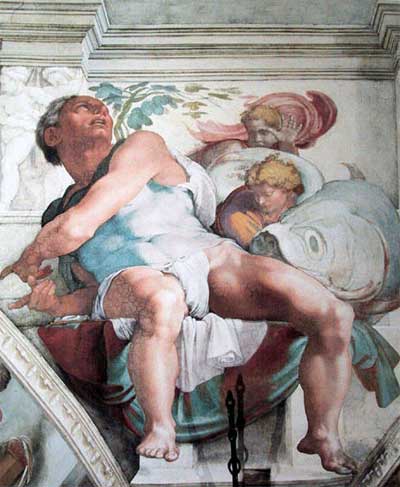
Jonah, as depicted by Michelangelo in the Sistine Chapel, with what appears to be a giant tarpon. Was this the fish that swallowed the prophet?
IN OCTOBER 2011 I walked into the Sistine Chapel for the second time in twenty years, and looking above the altar I was astounded to see a tarpon peering out from behind Jonah’s left leg. The tarpon (Megalops atlanticus) is one of my favorite light-tackle sport fish, because it readily takes flies and is a spectacular fighter.
Many questions came to mind, because this fresco, painted on the ceiling of the Sistine Chapel by Michelangelo around 1510, is probably the earliest accurate depiction of an Atlantic tarpon. I was not the first to notice this historically significant representation. Others have speculated as to what kind of fish (or whale) Michelangelo had painted next to Noah, and whether this was the fish that might have swallowed the prophet.
I tried to answer most of the questions for myself and conjecture on the facts, and I share the results here.
What is the earliest written record of the tarpon?
Portuguese explorers sailing south in caravels reached Senegal and Cape Verde Peninsula (15 deg. north) in 1444. This should be the earliest recorded date that western Europeans would have encountered the tarpon in their home range. Some African tarpon may have strayed north past Cape Boujdour (26 deg. north) prior to the 16th century. Currently the Eastern Atlantic waters in that region are inhospitably cold to tarpon.
What is the earliest piscatorial pictorial of a tarpon? (Probably Michelangelo!)
Ascanio Condivi, a pupil and assistant to Michelangelo, recorded that the artist had gone to a market to draw fish scales, a feature not present in one of the original engravings of fish. The interesting thing is that Michelangelo’s tarpon looks so large and so realistic. The painter must have had accurate drawing or seen a tarpon himself. However, a tarpon carcass of that size would have rotted away in the trip from Senegal to Italy, or if Columbus had brought a western Atlantic tarpon back a few years before, it would have been at best a dried specimen.
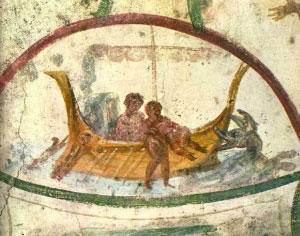
In the catacomb of St. Peter and St. Marcellino, Rome, a mural of Jonah being thrown into the sea.
So where did Michelangelo get his subject tarpon?
What was the historical range (500 years ago) of the tarpon?
The West Atlantic range is from 5 deg. south to 35 deg. north. The East Atlantic range is from 5 deg. south to 15 deg. north. Tarpon have been reported in Ireland and northwestern Europe, apparently riding the warm waters of the Gulf Stream through the North Atlantic. The Straits of Gibraltar are at 36 degrees north, but tarpon have never been reported in the Eastern Atlantic between 26 and 50 degrees north. We can conclude that tarpon have not strayed into the waters of the Mediterranean during recent times.
The East and West Atlantic tarpon are the same species. The West Atlantic tarpon populations have more genetic variation than the East Atlantic with the tarpon in eastern Brazil being genetically closest to the African tarpon. We do not have sufficient genetic information to determine when the east Atlantic populations diverged from the western Atlantic populations.
The closest relative of the tarpon is the oxeye, or Indo-Pacific tarpon (Megalops cyprinoides) which grows to over 40 pounds in weight and is found in the Western Pacific and Indian Ocean, including the Arabian Sea. This fish, which looks identical to the Atlantic tarpon, would have been well known to the Persians of the 13th century.
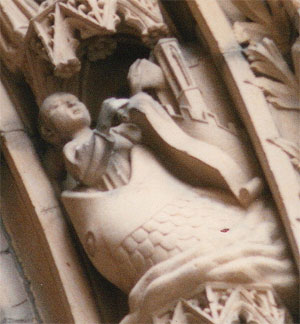
Depiction of Jonah and the whale on the south doorway of the Dom St. Peter in Worms, Germany.
Judging from the relative size of the figure of Jonah, and taking into account the foreshortening, the tarpon appears to be over 150 pounds. Photogrammetric measurements could be made to more accurately judge the size of this tarpon, but it was huge. Maybe Michelangelo worked from smaller specimens and relied on stories told of the great size some of the tarpon seen free-jumping south of Cape Verde and the Caribbean. As far as we know, the sport of catching tarpon with fishing rods and reels did not become popular until the latter part of the 19th century.
Some Historical Background
Being a student of the physical world, I have always thought that one of the best ways to understand and learn many of the technical developments over the ages is to approach the subject from a chronological viewpoint. I think that the human brain gets a better grasp of the subject if the information is presented in the same sequence that these developments were discovered historically.
Here is some information that you might find interesting—or that may even lead you to your own conclusions about Michelangelo’s tarpon:
- Remains of a 2nd-century Roman shipwreck showed signs of an ancient pumping system designed to suck sea water into a tank. This has led to speculation that the ancient Romans might have traded live fish across the Mediterranean Sea by fitting their ships with an ingenious hydraulic system, which consisted of a pumping system designed to suck the sea water into a fish tank through a lead pipe inserted in the hull near the keel. Recovered in pieces from the Adriatic Sea in 1999, the ship was carrying a cargo of fish when it sank six miles off the coast of Grado in northeastern Italy.
- In northern waters the longship was developed over a period of centuries and perfected by its most famous users, the Vikings, in approximately the 9th century. These ships were clinker-built, utilizing overlapping wooden strakes, and were primarily used to transport trading goods and supplies across the Baltic and North Atlantic. The Vikings also developed the cog (or cog-built vessels), which are a type of ship that first appeared in the 10th century and were widely used from around the 12th century on. Cogs were generally built of oak, which was an abundant timber in the Baltic region of Prussia. These vessels were fitted with a single mast and a square-rigged single sail and were mostly associated with seagoing trade in medieval Europe, especially in the Hanseatic League Baltic Sea region.
-
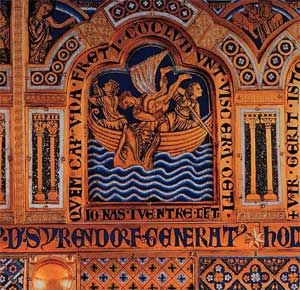
Detail of the Verduner altarpiece in Klosterneuburg, Austria by Nicholas of Verdun. Jonah in the whale.
Until the 14th century, the lateen (“Latin”) sail was employed primarily on the Mediterranean Sea, while Atlantic, Baltic and Indian Ocean vessels relied on square-rigged sails. The adoption of the specialized lateen sail in the Late Middle Ages was one of the technological developments that made ships more maneuverable when sailing into the wind. This enabled exploreers and merchants to sail out of the Mediterranean and into the Atlantic Ocean despite the prevailing onshore breeze.
- The Portuguese generally began their extended explorations of the Western Atlantic coastline at the end of the western European bubonic plague in 1350. The medieval warm period ended at the beginning of the 14th century with the onset of the Little Ice Age, and subsequent rains during the great famine of 1315 – 1317 decimated rural populations. When the plague came to southwest Europe in 1349 so many more farm workers died that farming was no longer a viable way of life. The result was that most of the people remaining migrated toward the coasts where they could live off the sea.
- The carrack, or nau, was a three or four-masted sailing ship developed by merging the Norse clinker-built hull technology with the lateen sail of the Mediterranean in the 14th and 15th centuries. Its invention is generally credited to the Portuguese people, who were the first western Europeans to explore the Atlantic south along the coast of Africa. Due to continuing conflicts with the African traders, the Iberians were searching for a trade route to the Far East in order to avoid the costly middlemen of the Eastern Mediterranean civilizations, who sat upon the routes of the slave and spice trade. Spices in that era were expensive luxuries and were also used medicinally.
- Even to this day in the Old Port, or Vieux-Port, of Marseilles, France the fishmongers sell their fish live from high-sided tables with fresh seawater being constantly circulated. Besides the bottom fish like sea bass, gurnards, whiting, flounder and porgys, ancient fisherman also caught live mackerel and small bonito, keeping their catch in large livewells until they returned to port.
Norman’s Speculations
When the Portuguese sailors went down the west coast of Africa, they would have used their considerable fishing skills to catch a large portion of their diet. The fishing methods of that era were hand lines and nets; when they entered regions that were inhabited by tarpon they would have caught the smaller specimens by hook-and-line or nets. Tarpon free-jump frequently, however, and when a tarpon is hooked they jump, greyhound and put up spectacular aerial displays. The fishing methods used at that time were crude when compared to modern day methods, and it would have been difficult to catch anything larger than 50 pounds. Larger tarpon would have torn up their fishing gear.
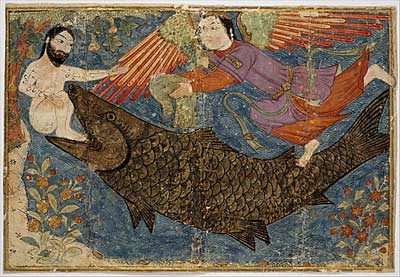
“Jonah and the Whale,” Folio from a Jami al-Tavarikh (Compendium of Chronicles), Islamic, Timurid period (1370–1507), ca. 1400. The Metropolitan Museum of Art, Purchase, Joseph Pulitzer Bequest, 1933( 33.113) www.metmuseum.org.
Inscription on the arms of Jonah, in Persian: “The sun’s disk went into darkness; Jonah went into the mouth of the fish.” The medium includes silver, and silver oxidizes to black/brown, so the original fish may have been silver just like an oxeye or tarpon.
In the days prior to refrigeration, food would rot in a very short time, especially in warm climates without salting. I suspect that many of the ships in that era would have had fish tanks to keep the smaller fish alive and fresh to eat. If so, smaller tarpon could have been brought back to Iberia without rotting, not only by the Portuguese but also by Columbus prior to 1500. The sailors would have told fantastic tales, of fish that jumped to the skies and were large enough to swallow a man. In the Old Testament Jonah appears in 2 Kings as a prophet, and in a storm he is thrown overboard and calmed the seas, only to be swallowed by a fish sent by God. In the Qur’an, chapter 37-142, Jonah is also swallowed by a fish. In the New Testament (Matthew 12: 39-41), Jonah is swallowed by a whale—apparently the result of differing translations. Therefore, Michelangelo may have been looking for a fish instead of a whale for his fresco of Jonah. If, down at the seaside fish markets, he heard the sailors’ tales of giant fish that could swallow a man and leapt to the heavens, he may have sought out a specimen to sketch and paint in his famous fresco.
Fishing for large tarpon is a visceral and emotional experience. Most people get weak-kneed when they face these amazing fish, which have survived in the world’s ocean for eons. These historical images help tie our modern passion for these fish to the legends, lessons and even spirituality of the long-ago past.











